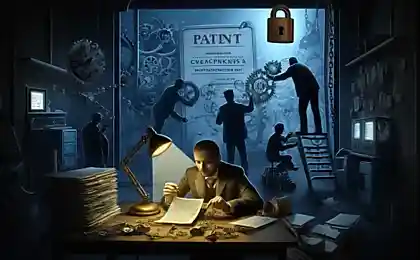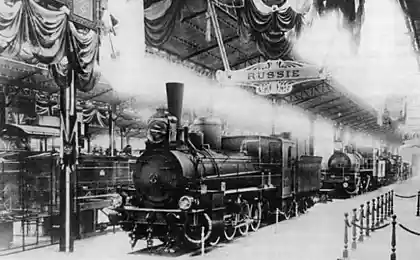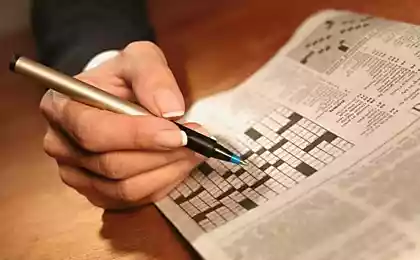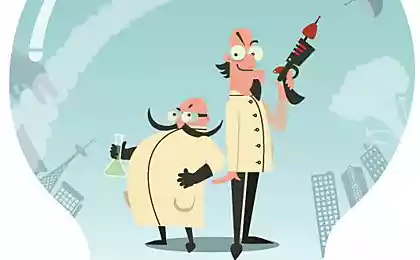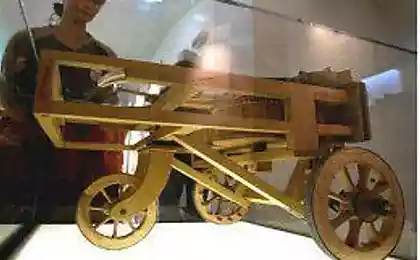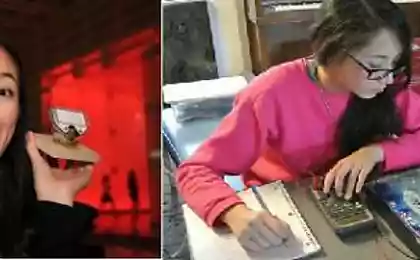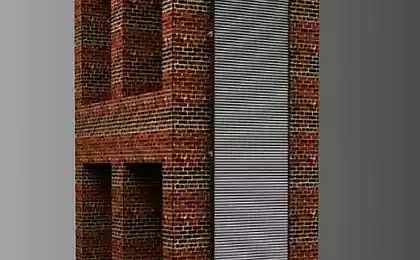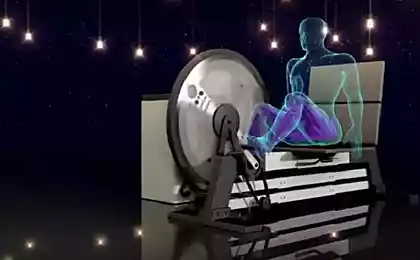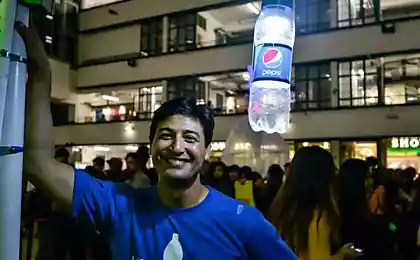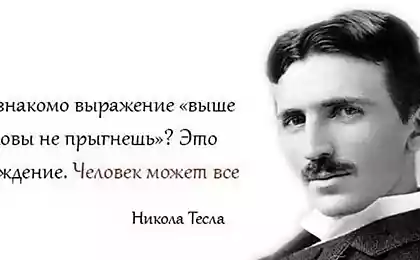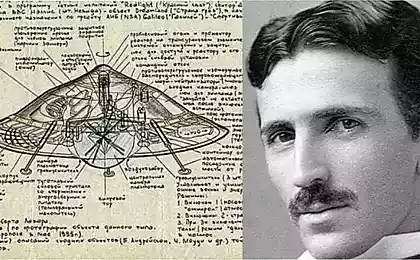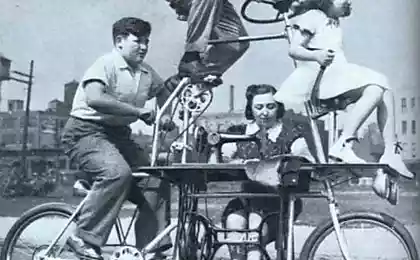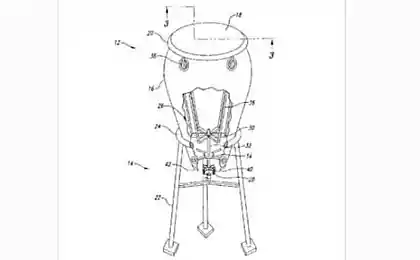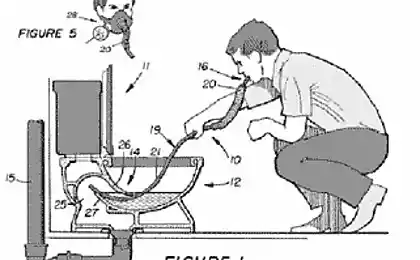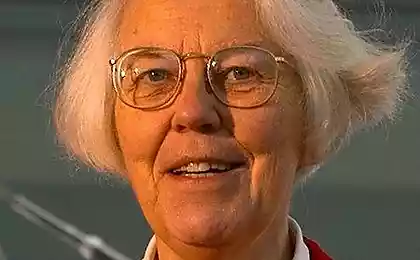1352
Inventions Kulibina
Everyone knows that Kulibin - a great Russian inventor, mechanic, engineer. His name has long since become a household name in Russian. But, as shown by a recent survey, only five percent of respondents could name at least one of his invention. How so? We decided to spend a small educational program: So, what is invented Ivan Kulibin?
Ivan, born in the village refurbish near Nizhny Novgorod in 1735, was an incredibly talented man. Mechanics, engineering, time fishing, shipbuilding - all disputes in the capable hands of Russian self-taught. It was a success and was close to the Empress, but none of his projects that can make life easier for ordinary people and promoting the progress was neither adequately funded nor implemented by the state. While entertaining mechanisms - funny automatons, palace clock, self-propelled guns - financed with great joy.
3 photos and text
01. Monument Kulibin
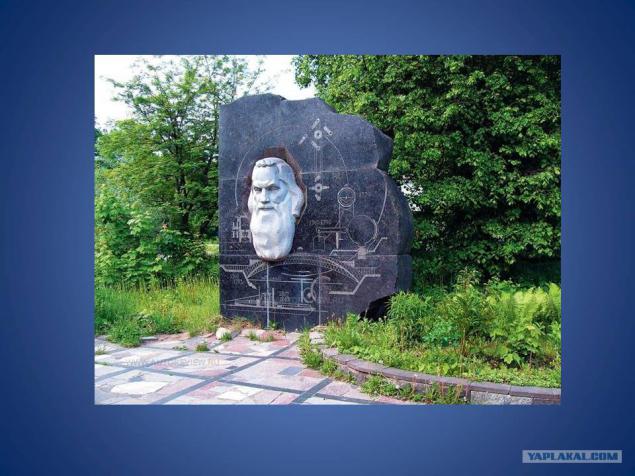
Amphibious ship
At the end of the XVIII century, the most common method of lifting loads on ships against the current was Burlatskii work - heavy, but relatively inexpensive. There are alternatives: for example, the machine ships, driven by oxen. Device Machine vessel was as follows: it had two anchors, ropes which are mounted on a special shaft. One of the anchors on the boat or on the shore was delivered ahead 800-1000 m and fixes. Oxen working on the ship, the rotating shaft and screw anchor rope, pulling the boat to the anchor against the current. At the same time, another boat was carrying forward the second anchor - so provides continuous motion.
Kulibin had an idea how to do without oxen. His idea was to use two wheels with blades. During the rotating wheel to transmit energy to the shaft - Screw anchor rope and the ship pulls up to the anchor itself by using the energy of water.
In operation Kulibina constantly distracted orders for toys for royal offspring, but he managed to knock the funding for the manufacture and installation of your system on a small boat. In 1782, it was loaded with nearly 65 tons (!) Of sand, revealed itself as a reliable and much faster than a ship or ox-drawn Burlatskii.
In 1804, in Nizhny Novgorod Kulibin built a second Vodochody, which was twice as fast Burlatskii Ext. Nevertheless, the Department of Water Communications at Alexander I rejected the idea and banned funding - Vodochody has not become widespread. Much later in Europe and the United States appeared capstans - ships that hauled himself to the anchor, using the energy of the steam engine.
Screw lift
The most common lift system today is a cabin on the winch. Winch lifts were created long before the patents Otis middle of the XIX century - similar designs acted in ancient Egypt, they were driven by draft animals or slave force.
In the mid 1790s the aging and fattened Catherine II commissioned Kulibin develop a convenient elevator to move between floors of the Winter Palace. She longed to lift-chair, and stood before Kulibin interesting technical challenge. By a similar lift, sun top, it was impossible to attach the winch, and if the "pick up" a chair below the winch, it would cause inconvenience to passengers.
Kulibin cleverly solved the problem: the base seat is fastened to the long axis of the screw, and move through it like a nut. Catherine sat on his mobile throne, the servant turned the handle, the rotation is transmitted to the axle, and she lifted a chair on the second floor gallery. Screw lift Kulibina was completed in 1793, and the second in the history of such a mechanism Elisha Otis built in New York in just 1859. After the death of Catherine's court elevator used for entertainment, and was later bricked. To date, save the drawing, and the remnants of the lifting mechanism.
02. Famous clock egg will work Kulibin in 1764-1767 years and presented to Catherine II at Easter 1769. Now kept in the Hermitage. Largely thanks to this gift Kulibin led workshops at the St. Petersburg Academy of Sciences.
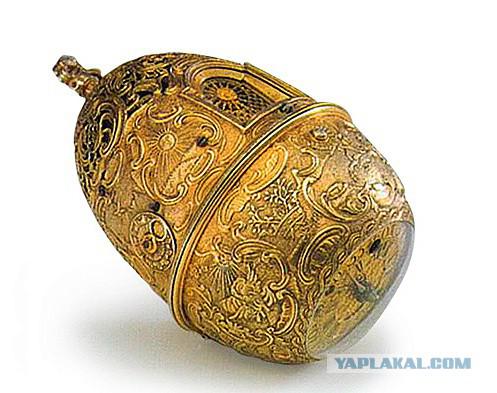
Theory and practice of bridge building
From the 1770s until the early 1800s Kulibin worked on the creation of a stationary single-span bridge over the Neva. He made a working model in which the calculated stresses and strains in different parts of the bridge - though the theory of bridge construction at that time did not exist!
Empirically Kulibin predicted and formulated a series of laws sopromata receiving confirmation much later. First inventors to develop a bridge at his own expense, but the final layout of the money allocated to it Count Potemkin. 1:10 scale model reaches a length of 30 m.
All calculations were presented to bridge the Academy of Sciences and verified the famous mathematician Leonhard Euler. It was found that the calculations are correct, and test the model showed that the bridge has a huge margin of safety; his height allow sailing ships to pass without any special operations. Despite the approval of the Academy, the government has not allocated funds for the construction of the bridge. Kulibin was awarded a medal and won the award in 1804, the third model completely rotted away, and the first permanent bridge across the Neva (Annunciation) was built only in 1850.
In 1936 he held an experimental calculation kulibinskogo bridge modern methods, and found that Russian autodidact not make any mistakes, though in his time, most of the laws sopromata were unknown. The method of manufacture and testing of its models with the aim of calculating the power bridge structure subsequently became widespread, it at different times, independently came various engineers. Also Kulibin first proposed the use in the construction of the bridge trusses - 30 years before the patent this system of American architect Itielya Town.
On the bridge over the Neva
Despite the fact that no serious Kulibina invention has not been evaluated for real, he was lucky much more than many other Russian self-taught, which either were not allowed even on the threshold of the Academy of Sciences, or sent back home with a $ 100 prize and a recommendation is no longer mind his own business.
Samobeglaya stroller and other stories
Often Kulibin besides really invented it structures attributed many others that he really improved, but not the first. For example, Kulibin very often credited with inventing the pedal samokatka (a prototype velomobile), while such a system created 40 years earlier another Russian self-taught engineer and Kulibin was second. Consider some of the common misconceptions.
So, in 1791 Kulibin built and presented the Academy of Sciences of self-propelled carriage "samobegluyu stroller", is essentially a forerunner velomobile. It was designed for one passenger, but was not the inventor dvKulibin velomobile - 40 years before it similar in design samobegluyu stroller built in St. Petersburg, another self-taught inventor Leonti Shamshurenkov (known in particular, the development of lifting the Tsar Bell, which did not has been used for its intended purpose).
The design was a double Shamshurenkova in later drawings inventor planned to build a self-propelled sleigh with verstomerom (prototype speedometer), but, alas, did not receive proper funding. As samokatka Kulibina, samokatka Shamshurenkova to our days is not reached.
Prosthetic leg
At the turn of XVIII-XIX vv.ekov Kulibin presented the St. Petersburg Medical-Surgical Academy, several projects "mechanical legs" - quite perfect for those times lower-limb prostheses that can mimic the lost above the knee (!) Leg. "Testers" of the first embodiment of the prosthesis, made in 1791, was Sergei Vasilievich Nepeytsyn - at that time a lieutenant, who lost his leg during the assault Ochakova.
Subsequently Nepeytsyn promoted to Major General and was among the soldiers nicknamed Iron Leg; he led a full life, and not all can guess why Gen. slightly limping. Prosthesis system Kulibina despite favorable reviews of Petersburg physicians led by Professor Ivan Bush, was rejected by the military establishment, and the mass production of mechanical prostheses that mimic the shape of the legs, began later in France.
Spotlight
In 1779, fond of optical devices Kulibin presented Petersburg public his invention - the spotlight. System of reflecting mirrors existed before it (in particular, were used in lighthouses), but the design Kulibina was significantly closer to the modern projectors: one single candle reflected from the placed in a concave hemisphere mirror reflectors, giving a strong and directional flow of light. "Wonderful Lantern" was positively received by the Academy of Sciences, praised in the press, approved by the Empress, but there was only a distraction and has not been used for street lighting, as originally believed Kulibin. The master subsequently produced a series of spotlights on individual orders korablevladeltsev and also made on the basis of the same system for compact lantern carriage - it brought him some income. Master summed lack of copyright protection - karetnye "kulibinskie lights" began to massively do wizards that greatly depreciated invention.
What else did Kulibin?
- Organize the work of the workshops at the St. Petersburg Academy of Sciences, where he was engaged in manufacturing of microscopes, barometers, thermometers, telescopes, scales, telescopes and many other laboratory instruments.
- Renovated planetarium Petersburg Academy of Sciences.
- Came up with an ingenious system of descent of the water of ships.
- Created by Russia's first optical telegraph (1794) posted in Kunst-camera as curiosities.
- Developed the first project in Russia iron bridge (the Volga).
- Constructed a seed drill, provides uniform seeding (not built).
- Fireworks, creating mechanical toys and automata for the entertainment of the nobility.
- Renovated and independently collected many hours of different layouts - wall, floor, tower.
source
03. Flashlight Searchlight, created in 1779, and remained a technical gimmick. In everyday life - as lanterns on the crew - only apply its reduced version.
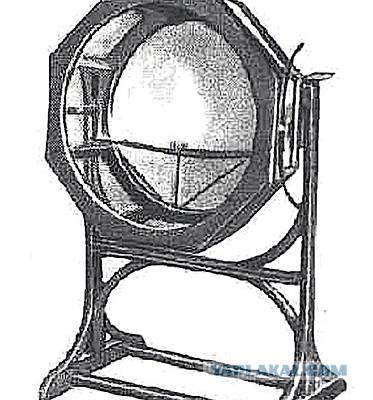
Ivan, born in the village refurbish near Nizhny Novgorod in 1735, was an incredibly talented man. Mechanics, engineering, time fishing, shipbuilding - all disputes in the capable hands of Russian self-taught. It was a success and was close to the Empress, but none of his projects that can make life easier for ordinary people and promoting the progress was neither adequately funded nor implemented by the state. While entertaining mechanisms - funny automatons, palace clock, self-propelled guns - financed with great joy.
3 photos and text
01. Monument Kulibin

Amphibious ship
At the end of the XVIII century, the most common method of lifting loads on ships against the current was Burlatskii work - heavy, but relatively inexpensive. There are alternatives: for example, the machine ships, driven by oxen. Device Machine vessel was as follows: it had two anchors, ropes which are mounted on a special shaft. One of the anchors on the boat or on the shore was delivered ahead 800-1000 m and fixes. Oxen working on the ship, the rotating shaft and screw anchor rope, pulling the boat to the anchor against the current. At the same time, another boat was carrying forward the second anchor - so provides continuous motion.
Kulibin had an idea how to do without oxen. His idea was to use two wheels with blades. During the rotating wheel to transmit energy to the shaft - Screw anchor rope and the ship pulls up to the anchor itself by using the energy of water.
In operation Kulibina constantly distracted orders for toys for royal offspring, but he managed to knock the funding for the manufacture and installation of your system on a small boat. In 1782, it was loaded with nearly 65 tons (!) Of sand, revealed itself as a reliable and much faster than a ship or ox-drawn Burlatskii.
In 1804, in Nizhny Novgorod Kulibin built a second Vodochody, which was twice as fast Burlatskii Ext. Nevertheless, the Department of Water Communications at Alexander I rejected the idea and banned funding - Vodochody has not become widespread. Much later in Europe and the United States appeared capstans - ships that hauled himself to the anchor, using the energy of the steam engine.
Screw lift
The most common lift system today is a cabin on the winch. Winch lifts were created long before the patents Otis middle of the XIX century - similar designs acted in ancient Egypt, they were driven by draft animals or slave force.
In the mid 1790s the aging and fattened Catherine II commissioned Kulibin develop a convenient elevator to move between floors of the Winter Palace. She longed to lift-chair, and stood before Kulibin interesting technical challenge. By a similar lift, sun top, it was impossible to attach the winch, and if the "pick up" a chair below the winch, it would cause inconvenience to passengers.
Kulibin cleverly solved the problem: the base seat is fastened to the long axis of the screw, and move through it like a nut. Catherine sat on his mobile throne, the servant turned the handle, the rotation is transmitted to the axle, and she lifted a chair on the second floor gallery. Screw lift Kulibina was completed in 1793, and the second in the history of such a mechanism Elisha Otis built in New York in just 1859. After the death of Catherine's court elevator used for entertainment, and was later bricked. To date, save the drawing, and the remnants of the lifting mechanism.
02. Famous clock egg will work Kulibin in 1764-1767 years and presented to Catherine II at Easter 1769. Now kept in the Hermitage. Largely thanks to this gift Kulibin led workshops at the St. Petersburg Academy of Sciences.

Theory and practice of bridge building
From the 1770s until the early 1800s Kulibin worked on the creation of a stationary single-span bridge over the Neva. He made a working model in which the calculated stresses and strains in different parts of the bridge - though the theory of bridge construction at that time did not exist!
Empirically Kulibin predicted and formulated a series of laws sopromata receiving confirmation much later. First inventors to develop a bridge at his own expense, but the final layout of the money allocated to it Count Potemkin. 1:10 scale model reaches a length of 30 m.
All calculations were presented to bridge the Academy of Sciences and verified the famous mathematician Leonhard Euler. It was found that the calculations are correct, and test the model showed that the bridge has a huge margin of safety; his height allow sailing ships to pass without any special operations. Despite the approval of the Academy, the government has not allocated funds for the construction of the bridge. Kulibin was awarded a medal and won the award in 1804, the third model completely rotted away, and the first permanent bridge across the Neva (Annunciation) was built only in 1850.
In 1936 he held an experimental calculation kulibinskogo bridge modern methods, and found that Russian autodidact not make any mistakes, though in his time, most of the laws sopromata were unknown. The method of manufacture and testing of its models with the aim of calculating the power bridge structure subsequently became widespread, it at different times, independently came various engineers. Also Kulibin first proposed the use in the construction of the bridge trusses - 30 years before the patent this system of American architect Itielya Town.
On the bridge over the Neva
Despite the fact that no serious Kulibina invention has not been evaluated for real, he was lucky much more than many other Russian self-taught, which either were not allowed even on the threshold of the Academy of Sciences, or sent back home with a $ 100 prize and a recommendation is no longer mind his own business.
Samobeglaya stroller and other stories
Often Kulibin besides really invented it structures attributed many others that he really improved, but not the first. For example, Kulibin very often credited with inventing the pedal samokatka (a prototype velomobile), while such a system created 40 years earlier another Russian self-taught engineer and Kulibin was second. Consider some of the common misconceptions.
So, in 1791 Kulibin built and presented the Academy of Sciences of self-propelled carriage "samobegluyu stroller", is essentially a forerunner velomobile. It was designed for one passenger, but was not the inventor dvKulibin velomobile - 40 years before it similar in design samobegluyu stroller built in St. Petersburg, another self-taught inventor Leonti Shamshurenkov (known in particular, the development of lifting the Tsar Bell, which did not has been used for its intended purpose).
The design was a double Shamshurenkova in later drawings inventor planned to build a self-propelled sleigh with verstomerom (prototype speedometer), but, alas, did not receive proper funding. As samokatka Kulibina, samokatka Shamshurenkova to our days is not reached.
Prosthetic leg
At the turn of XVIII-XIX vv.ekov Kulibin presented the St. Petersburg Medical-Surgical Academy, several projects "mechanical legs" - quite perfect for those times lower-limb prostheses that can mimic the lost above the knee (!) Leg. "Testers" of the first embodiment of the prosthesis, made in 1791, was Sergei Vasilievich Nepeytsyn - at that time a lieutenant, who lost his leg during the assault Ochakova.
Subsequently Nepeytsyn promoted to Major General and was among the soldiers nicknamed Iron Leg; he led a full life, and not all can guess why Gen. slightly limping. Prosthesis system Kulibina despite favorable reviews of Petersburg physicians led by Professor Ivan Bush, was rejected by the military establishment, and the mass production of mechanical prostheses that mimic the shape of the legs, began later in France.
Spotlight
In 1779, fond of optical devices Kulibin presented Petersburg public his invention - the spotlight. System of reflecting mirrors existed before it (in particular, were used in lighthouses), but the design Kulibina was significantly closer to the modern projectors: one single candle reflected from the placed in a concave hemisphere mirror reflectors, giving a strong and directional flow of light. "Wonderful Lantern" was positively received by the Academy of Sciences, praised in the press, approved by the Empress, but there was only a distraction and has not been used for street lighting, as originally believed Kulibin. The master subsequently produced a series of spotlights on individual orders korablevladeltsev and also made on the basis of the same system for compact lantern carriage - it brought him some income. Master summed lack of copyright protection - karetnye "kulibinskie lights" began to massively do wizards that greatly depreciated invention.
What else did Kulibin?
- Organize the work of the workshops at the St. Petersburg Academy of Sciences, where he was engaged in manufacturing of microscopes, barometers, thermometers, telescopes, scales, telescopes and many other laboratory instruments.
- Renovated planetarium Petersburg Academy of Sciences.
- Came up with an ingenious system of descent of the water of ships.
- Created by Russia's first optical telegraph (1794) posted in Kunst-camera as curiosities.
- Developed the first project in Russia iron bridge (the Volga).
- Constructed a seed drill, provides uniform seeding (not built).
- Fireworks, creating mechanical toys and automata for the entertainment of the nobility.
- Renovated and independently collected many hours of different layouts - wall, floor, tower.
source
03. Flashlight Searchlight, created in 1779, and remained a technical gimmick. In everyday life - as lanterns on the crew - only apply its reduced version.

